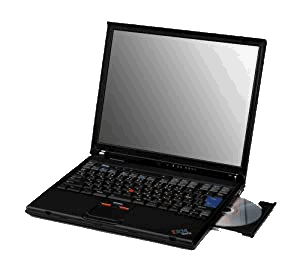Replacing an IDE HDD with an mSATA SSD
Note: it's been a few years since I did this upgrade and the laptop still works fine. The new drive should continue to last a long time and it still runs quick.

I own many old laptops. One of my ThinkPads experienced a drive failure, evidenced by a failure to load any OS and a loud clicking coming from the HDD. It was old--at least 15 years when it failed--and it was time for a replacement, and an upgrade. Rather than replacing the dead HDD with another HDD, I chose to use an mSATA SSD in conjunction with an adapter.
Here are a few reasons:
- SSDs won't be damaged by physical shocks, like bumps or drops, like HDDs are. A hard knock during travel was what finally caused my old HDD to stop working. For a laptop, this is more important than if the drive were for a desktop.
- The SSD has faster data transfer rates. This means the system will boot and run faster.
- While HDDs are the best choice for large amounts of data storage, older laptops with IDE drives generally had relatively low storage capacity to begin with, so even a small SSD isn't a big deal. Depending on the use case a laptop might not need large amounts of storage anyway.
- An SSD has a lower power draw than an HDD. It's also a lot quieter.
- mSATA SSDs now are not very expensive. They are still more expensive than an equivalent HDD, but I paid about $28 for the SSD and $7 for an adapter which isn't a bad price.
Procedure
The process was simple with a couple minor problems.
The first thing to do is remove the old HDD along with its drive caddy. I expected to be able to fit the mSATA adapter right into the caddy, as I assumed that it was a standard size that would fit correctly.
My assumption was incorrect. Although the adapter I purchased appeared at first glance to be the size of a typical 2.5" drive, it was slightly larger all around and therefore wouldn't fit into the caddy.
This proved not to be a problem, since the adapter was large enough on its own to slide snugly into the drive bay and plug in. Your mileage may vary, but in my case I didn't have to shave down the plastic case for the adapter or shim it to plug in properly.
Once I knew it would fit, I took it back out. To use the adapter, you just plug your mSATA SSD into the port on the adapter's PCB and screw it down into place if needed. The whole thing just plugs in where your IDE drive used to be.
You can boot up and install your new OS, or if you've thought ahead and your old drive isn't dead, you could maybe use a command such as dd to copy over everything from the old drive to the new one provided you have a computer which you can plug both into at the same time. Or you could dump the old data to a computer with enough space, then put that back onto the new one. In my case, I simply reinstalled my OS. For this laptop, it was Windows XP.
Results
I did not take speed meaurements or use any testing software to measure how well my new SSD performed. I couldn't have made a comparison easily anyway since the old drive was completely dead.
I did measure the time it took to boot up, however. With the old IDE HDD with only Windows XP installed, the entire boot process took 2 minutes or more.
On the new drive, I installed Windows XP alongside Debian, with GRUB as a bootloader. My laptop is strange in that it takes a while to boot to BIOS no matter what drive is installed. Booting to GRUB takes 15 to 20 seconds, however once Windows XP is selected, booting from there takes only 10 seconds to load the OS and log in.
With the older drive, if I wanted to open a Web browser in XP, I would have had to wait 2 minutes to boot, then an additional 30 seconds to load everything and open a browser.
With the mSATA drive, I can have a Web browser already open and accessing a Web page within maybe 30 to 45 seconds of booting.
Boot time obviously isn't the only thing that can be improved, but it shows how effective the replacement was.
I now have a quieter, cooler laptop; longer battery life; improved protection against bumps; and an overall quicker system
It was worth it for me. If you attempt to revive an old laptop this way, good luck. You won't be sorry.